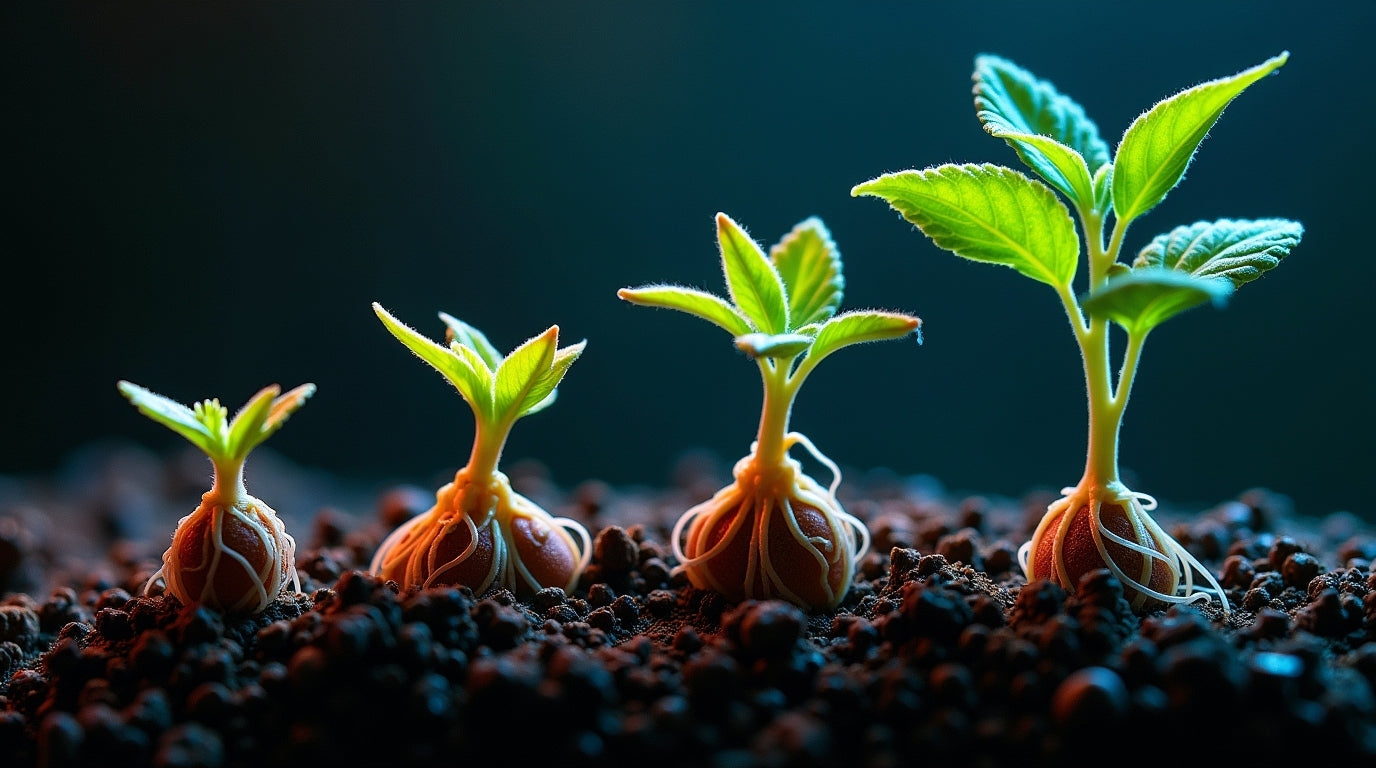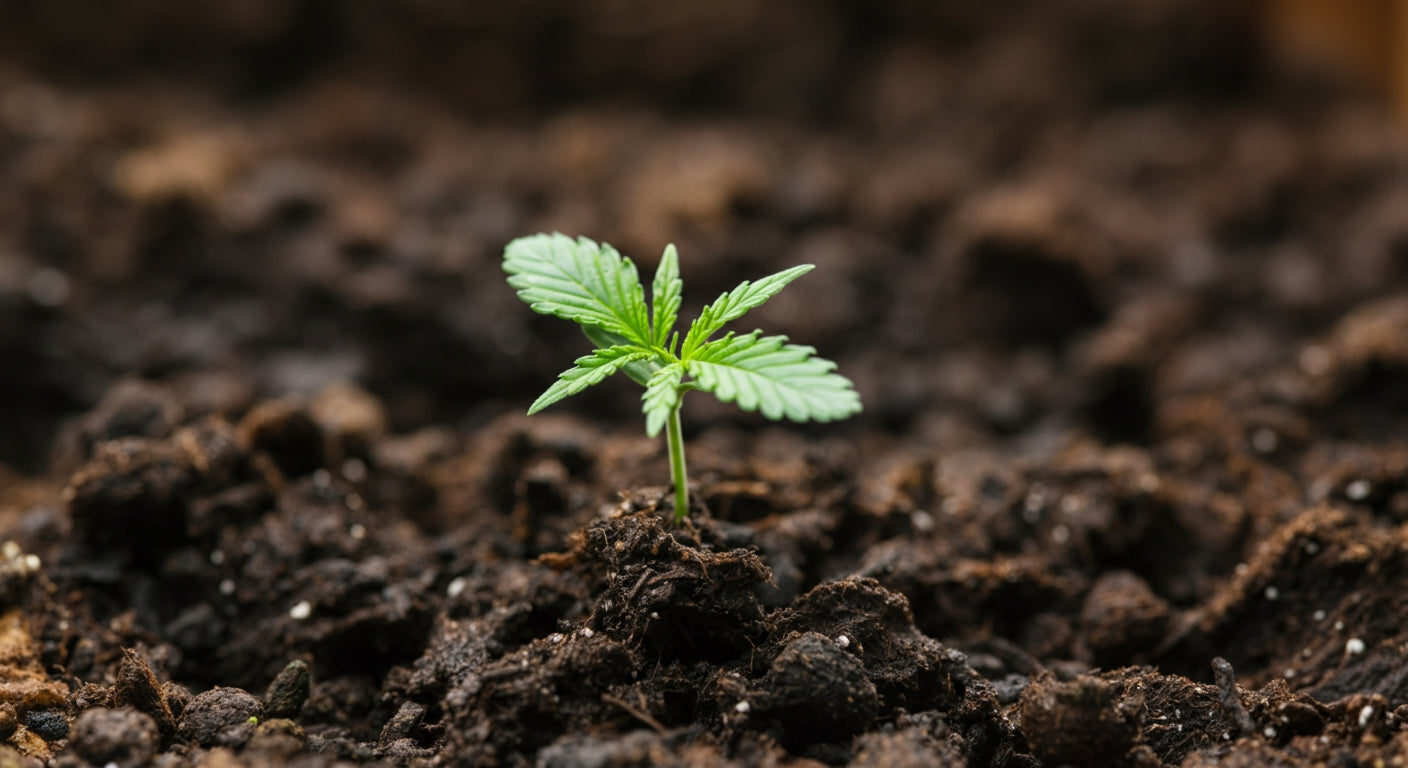
How to Grow Cannabis from Seed: Your Complete Step-by-Step Guide
Growing cannabis from seed offers the most rewarding and comprehensive cultivation experience, allowing you to witness and control every stage of your plant's development from germination to harvest. Unlike clones, seeds provide genetic diversity, stronger root systems, and the excitement of discovering each plant's unique characteristics.
Starting from seed gives you access to countless strain varieties, better plant vigor, and the satisfaction of completing the entire growing cycle. While it requires more time and patience than clone cultivation, the results often surpass expectations with proper technique and equipment.
This comprehensive guide walks you through every step of growing cannabis from seed, from selection and germination to harvest and beyond. With the right approach and professional growing environment, you can achieve exceptional results even as a first-time grower.

Why Grow Cannabis from Seed?
Advantages of Seed Growing
Genetic Diversity and Vigor:
- Access to thousands of strain varieties worldwide
- Stronger, more robust root systems than clones
- Natural genetic variation within each strain
- Disease resistance and adaptation capabilities
Cost Effectiveness:
- Seeds cost significantly less than clones
- One seed packet provides multiple plants
- No need to maintain mother plants
- Eliminates clone transportation risks
Quality Control:
- Start with fresh, clean genetics
- Avoid pests and diseases from clone sources
- Control entire growing process from beginning
- Develop personal growing skills and knowledge
Legal Advantages:
- Seeds are legal to purchase in many areas where plants aren't
- Easier to acquire and transport than clones
- Better documentation for legal compliance
- Access to genetics from specialized breeders
Seed vs. Clone Comparison
Seeds Provide:
- Stronger taproot development
- Better stress resistance
- Longer plant lifespan potential
- Greater genetic stability
Challenges with Seeds:
- Longer total growing time (2-4 weeks additional)
- Gender uncertainty (unless feminized)
- Germination requirements and risks
- More complex early-stage care
The extra time and effort invested in seed growing typically pays off with healthier, more productive plants throughout their lifecycle.
Cannabis Seed Types and Selection
Understanding Seed Types
Regular Seeds:
- Produce both male and female plants (50/50 ratio)
- Required for breeding programs
- Often more genetically stable
- Lower cost per seed
- Best for: Experienced growers, breeding projects
Feminized Seeds:
- 99%+ probability of female plants
- Eliminate need to identify and remove males
- Maximize growing space efficiency
- Higher cost but better value for most growers
- Best for: Personal cultivation, space-limited grows
Autoflowering Seeds:
- Flower automatically regardless of light schedule
- Faster harvest cycles (10-14 weeks total)
- Compact plant size ideal for small spaces
- Less photoperiod stress and light leak concerns
- Best for: Beginners, quick harvests, compact grow tent setups
Seed Quality Indicators
Visual Quality Assessment:
- Dark, mature colors: Brown, black, or tiger-striped patterns
- Hard shell: Seeds should feel firm, not soft or green
- Proper size: Plump, well-developed seeds
- Surface texture: Slight waxy coating, not cracked or damaged
Reputable Seed Sources:
- Licensed seed banks with good reputations
- Breeders with established track records
- Clear genetic lineage and growing information
- Proper storage and shipping practices
Storage Considerations:
- Store in cool, dark, dry conditions
- Airtight containers prevent moisture damage
- Refrigerator storage for long-term preservation
- Avoid temperature fluctuations and light exposure

Germination Methods and Techniques
Paper Towel Method (Most Popular)
Step-by-Step Process:
- Preparation: Gather paper towels, plates, and distilled water
- Setup: Dampen paper towels (moist, not soaking)
- Placement: Place seeds between towel layers
- Environment: Cover with plate, maintain 70-75°F
- Monitoring: Check every 12-24 hours for sprouting
- Timing: Taproots typically emerge in 24-72 hours
Success Tips:
- Use distilled or pH-balanced water
- Maintain consistent moisture without oversaturation
- Keep in warm, dark location
- Handle sprouted seeds gently by the seed body, not the root
Direct Soil Germination
Benefits:
- No transplant shock for sensitive seedlings
- Simulates natural germination process
- Reduces handling and contamination risks
- Better for larger-scale operations
Technique:
- Soil preparation: Use light, well-draining seedling mix
- Planting depth: 0.5-1 inch deep, pointed end down
- Moisture: Keep soil consistently moist but not waterlogged
- Environment: Maintain 70-75°F soil temperature
- Emergence: Seedlings appear in 3-10 days
Water Glass Method
Process:
- Place seeds in glass of room temperature water
- Keep in dark location for 12-24 hours
- Seeds sink when ready (float initially is normal)
- Transfer to paper towels or soil when taproots appear
Best For:
- Older or harder seeds that need extra moisture
- Seeds with particularly thick shells
- Growers wanting to pre-select viable seeds
Seedling Stage Care (Weeks 1-3)
Creating Optimal Seedling Environment
Lighting Requirements:
- Intensity: Start with lower intensity, gradually increase
- Schedule: 18 hours on, 6 hours off for healthy development
- Distance: 18-24 inches from LED lights initially
- Spectrum: Full spectrum or blue-heavy for vegetative growth
Environmental Conditions:
- Temperature: 70-75°F for optimal root development
- Humidity: 65-70% for healthy early growth
- Air circulation: Gentle airflow to strengthen stems
- Growing medium: Light, well-draining potting mix
A properly configured grow tent provides the controlled environment essential for healthy seedling development.
Seedling Care Essentials
Watering Practices:
- Water around the seedling, not directly on stem
- Use spray bottle for gentle, even moisture
- Allow slight drying between waterings
- Monitor for overwatering (most common seedling killer)
Nutrient Considerations:
- Avoid nutrients for first 1-2 weeks
- Quality potting soil contains sufficient early nutrition
- Start with 1/4 strength nutrients when first true leaves appear
- Monitor for nutrient burn (yellow/brown leaf tips)
Common Seedling Problems:
- Damping off: Fungal disease from excessive moisture
- Stretching: Inadequate light causes tall, weak stems
- Nutrient burn: Overfertilization damages young roots
- pH problems: Nutrient lockout from improper pH levels
Transplanting and Early Growth
When to Transplant:
- 2-4 sets of true leaves developed
- Roots visible at drainage holes
- Plant appears stable and healthy
- Usually 2-3 weeks after germination
Transplanting Technique:
- Water seedlings before transplanting
- Prepare larger containers with quality growing medium
- Handle by root ball, not stem
- Plant at same depth as previous container
- Water gently after transplanting

Vegetative Stage from Seed (Weeks 4-10)
Transitioning to Vegetative Growth
Environmental Adjustments:
- Lighting: Increase intensity as plants mature
- Temperature: 70-85°F during day, 60-70°F at night
- Humidity: Gradually reduce to 50-60%
- Space: Ensure adequate room for expansion
Nutrition and Feeding:
- Nitrogen focus: Higher nitrogen for leaf and stem development
- Feeding schedule: Every 2-3 waterings with nutrients
- pH monitoring: Maintain 6.0-7.0 for soil, 5.5-6.5 for hydro
- EC/PPM levels: Start low (400-600 PPM) and gradually increase
Plant Training for Seed-Grown Plants
Low Stress Training (LST):
- Bend branches to create even canopy
- Increases light penetration to lower branches
- Improves overall yield potential
- Start when plants have 4-6 nodes
Topping and Pruning:
- Remove main cola to encourage bushy growth
- Wait until plants have at least 5-6 nodes
- Creates multiple main colas instead of one
- Allow recovery time between training sessions
Advanced Techniques:
- SCROG (Screen of Green): Train branches through horizontal screen
- Supercropping: Strategic stem damage to increase yields
- Mainlining: Create symmetrical plant structure
- Defoliation: Remove select leaves for light penetration
Proper training techniques work especially well in height-adjustable grow tents that can accommodate changing plant structures.
Vegetative Growth Optimization
Light Management:
- Maintain 18/6 light schedule consistently
- Adjust light height as plants grow
- Monitor for light burn or insufficient lighting
- Consider light movers for even coverage
Space Utilization:
- Plan for 2-3x height increase during flowering
- Maintain adequate spacing between plants
- Utilize vertical space with training techniques
- Consider grow tent sizing for optimal results
Flowering Stage from Seed (Weeks 11-22)
Triggering Flowering
Light Schedule Change:
- Switch to strict 12 hours light, 12 hours darkness
- Ensure complete darkness during dark periods
- Maintain consistent schedule timing
- Use timers for precise control
Environmental Modifications:
- Temperature: Slightly cooler, 65-80°F
- Humidity: Reduce to 40-50% to prevent bud rot
- Air circulation: Increase for larger, denser plants
- Nutrient switch: Change to phosphorus/potassium-rich flowering nutrients
Environmental control becomes critical during flowering to prevent mold and maximize resin production.
Flowering Timeline and Development
Weeks 1-3 (Stretch Phase):
- Plants may double in height
- Gender becomes apparent (if growing regular seeds)
- Remove male plants immediately
- Continue training if needed
Weeks 4-6 (Bud Formation):
- Rapid bud development begins
- Increase phosphorus and potassium
- Monitor for nutrient deficiencies
- Maintain optimal environmental conditions
Weeks 7-9 (Bud Maturation):
- Trichome production peaks
- Monitor harvest readiness indicators
- Reduce nitrogen further
- Prepare for harvest timing
Weeks 10+ (Final Ripening):
- Monitor trichomes for harvest timing
- Consider flushing with plain water
- Reduce humidity for final weeks
- Prepare drying and curing equipment
Gender Identification and Management
Male Plant Identification:
- Pollen sacs develop at node intersections
- Appear 1-2 weeks into flowering
- Remove immediately to prevent pollination
- Save pollen if breeding is desired
Female Plant Characteristics:
- White pistils emerge from calyxes
- Develop into bud clusters over time
- Focus energy on bud development
- Protect from male pollen contamination
Hermaphrodite Management:
- Stress can cause female plants to develop male flowers
- Monitor closely for "bananas" or pollen sacs
- Remove affected plants or male parts immediately
- Prevent stress through consistent environment
Advanced Seed Growing Techniques
Maximizing Genetic Potential
Phenotype Selection:
- Grow multiple seeds of same strain
- Select best-performing individuals
- Consider yield, potency, and growth characteristics
- Keep detailed records for future reference
Environmental Optimization:
- CO2 supplementation for enhanced growth rates
- VPD control for optimal transpiration
- Spectrum tuning throughout growth stages
- Temperature differential for enhanced resin production
Seed Production and Breeding
Creating Your Own Seeds:
- Select superior male and female plants
- Control pollination timing and placement
- Harvest seeds when fully mature
- Store properly for future use
Breeding Considerations:
- Understand basic genetics and inheritance
- Keep detailed breeding records
- Test offspring for desired traits
- Consider professional breeding techniques
FAQ Section
Q: How long does it take to grow cannabis from seed to harvest? A: Cannabis from seed typically takes 5-7 months total: 1-2 weeks germination, 2-3 weeks seedling stage, 6-10 weeks vegetative growth, and 8-12 weeks flowering. Autoflowering varieties complete their cycle in 10-14 weeks regardless of light schedule.
Q: What's the difference between feminized and regular cannabis seeds? A: Feminized seeds produce female plants 99%+ of the time, eliminating the need to identify and remove males. Regular seeds produce approximately 50% male and 50% female plants. Feminized seeds are more expensive but maximize space efficiency for personal cultivation.
Q: Why do my cannabis seedlings keep dying? A: Common causes include overwatering (most frequent), inadequate lighting, temperature extremes, nutrient burn, or damping-off disease. Maintain proper moisture levels, provide adequate light, and avoid nutrients for the first 1-2 weeks to prevent seedling problems.
Q: Can I grow cannabis from seeds found in dispensary cannabis? A: Seeds from dispensary cannabis (bag seeds) can germinate and grow, but they're often immature or from hermaphrodite plants. They may produce inferior plants or develop hermaphrodite traits themselves. Professional seed banks offer much better genetics and reliability.
Q: How do I know if my cannabis seeds are good quality? A: Quality seeds are dark brown or black with tiger stripes, feel hard and full, and have a slight waxy coating. Avoid green, soft, cracked, or pale seeds. Purchase from reputable seed banks with proper storage and shipping practices for best results.
Featured Snippet Summary
How to grow cannabis from seed: Germinate seeds using paper towel method (24-72 hours), plant in light soil, provide 18/6 lighting for 2-3 weeks seedling stage, continue vegetative growth 6-10 weeks, switch to 12/12 lighting for 8-12 weeks flowering, then harvest when trichomes are 70% cloudy. Total time: 5-7 months seed to harvest.
Master the Complete Cannabis Growing Journey
Growing cannabis from seed represents the ultimate cultivation experience—witnessing your plants develop from tiny genetic packages into mature, potent harvests. This journey requires patience, skill, and most importantly, the right environment to support healthy development through every growth stage.
Gorilla Grow Tents provide the consistent, controlled environment essential for successful seed-to-harvest cultivation. With adjustable height systems that accommodate growth spurts, superior environmental control, and professional-grade construction, you get the reliable foundation needed for transforming seeds into premium cannabis.
From the delicate seedling stage requiring precise humidity control to the demanding flowering period needing perfect environmental conditions, professional grow tent systems eliminate the variables that can derail seed grows. Your genetics deserve the best possible environment to express their full potential.
Whether you're starting with a compact 3x3 setup for personal cultivation or planning a larger operation, having professional equipment ensures your seed investment pays off with consistent, high-quality harvests.
Ready to experience the complete satisfaction of seed-to-harvest growing? Explore our complete growing systems and join thousands of successful growers who trust Gorilla for their most important cultivation projects.
Take your seed growing expertise to the next level with our comprehensive guides on optimizing grow room environments and environmental control techniques that maximize seed growing success.

Lena Myles
I'm a mushroom enthusiast and home cook based in Oregon. I'm passionate about foraging and creating fungi-focused recipes, especially delicious, plant-based dishes using gourmet mushrooms like trumpet, shiitake, and oyster. When I’m not in the kitchen, you’ll usually find me wandering the woods in search of new wild flavors.


